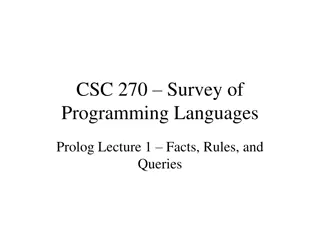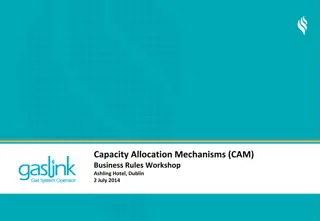Understanding Facts and Opinions in Reading Comprehension
Reading comprehension involves distinguishing between facts and opinions in a text. Facts can be objectively proven, while opinions are subjective reflections of personal feelings. Recognizing the difference is crucial for essay writing and critical analysis. By examining cues and asking specific qu
2 views • 9 slides
Understanding Civil Procedure Rules Parts 18-23
The new civil procedure rules cover various aspects such as counterclaims, additional claims, changes to parties, representative parties, miscellaneous rules, and rules regarding minors and patients. The overriding objective is to ensure cases are dealt with justly and at a proportionate cost, consi
1 views • 49 slides
Understanding Parliamentary Basics and the Purpose of Roberts Rules of Order
This content details the basics of parliamentary procedures, focusing on the purpose of Roberts Rules of Order in running meetings uniformly, facilitating business transactions, and protecting the rights of all members. It also highlights the hierarchy of rules, general rules of Robert, and the hist
0 views • 30 slides
Understanding Generalization: Facts, Opinions, and Validity
Exploring the concept of generalization, this content distinguishes between facts, opinions, and valid generalizations. It emphasizes how generalizations are broad statements based on information and experiences, while facts can be proven true and opinions are belief-based. Key words and examples ar
1 views • 8 slides
Motorboat Training, testing, and licensing: Rules of the Road & Aids to Navigation Manual
This presentation covers essential information on motorboat training, testing, and licensing, focusing on rules of the road and aids to navigation. It includes details on navigation rules, the importance of following them to prevent accidents, and where the rules apply. The content also explains who
0 views • 34 slides
Harvard Procedure Guidelines and Rules for Model United Nations
In this guide, you will explore the rules and procedures specific to the Harvard Procedure in Model United Nations. It covers general rules, guidelines on resolutions and voting, language requirements, courtesy expectations, rules of procedure, motions, points of order, and parliamentary inquiries.
4 views • 20 slides
Understanding Facts That Need Not Be Proved Under Evidence Act
The Evidence Act discusses Sections 56-58 covering facts that need not be proved, including judicially noticeable facts, admitted facts, and matters presumed to be true. Judicial notice allows courts to accept common knowledge without formal evidence, while Section 58 deems agreed facts as admitted
1 views • 13 slides
Understanding the New Civil Procedure Rules Parts 18-23
The new civil procedure rules cover various aspects like counterclaims, addition of parties, changes to case statements, representative parties, miscellaneous rules about parties, and rules regarding minors and patients. The overriding objective is to ensure cases are dealt with justly and at a prop
3 views • 49 slides
Civil Procedure Rules of the Supreme Court of The Bahamas, 2022
The Civil Procedure Rules of the Supreme Court of The Bahamas, 2022 detail the application of CPR to civil proceedings, highlighting exceptions, the Woolf Reforms, and key provisions such as active case management and the overriding objective. The rules also address proceedings commenced before the
2 views • 30 slides
Understanding the Difference Between Fact and Opinion
Learn how to distinguish between facts and opinions through clear examples and explanations. Discover how valid opinions can be supported by facts while faulty opinions may exhibit bias. Practice identifying facts and opinions and determining the validity of various statements. Enhance your critical
0 views • 27 slides
Financial and Eligibility Rules for EU Cooperation Programmes
Financial and eligibility rules for EU cooperation programmes include details on the first-level control unit, sources of information, hierarchy of rules, overarching eligibility rules, and reporting overview. These rules cover areas such as project activities, expenditure eligibility, procurement r
2 views • 27 slides
Association Rules with Graph Patterns: Exploring Relationships in Data
Dive into the world of association rules with graph patterns, where relationships and connections are analyzed through nodes and edges. Discover how to define association rules, identify customers, and uncover interesting patterns using graph-based techniques. Explore traditional and graph-pattern a
2 views • 18 slides
Power, Decision Making, and Rules in a School Environment
Explore the dynamics of power, decision-making, and rules within a school setting, analyzing concepts such as Locke's Social Contract, the Stanford Prison Experiment, and the distribution of power among stakeholders like teachers, students, and administrators. Reflect on safety rules, enforcement, a
0 views • 15 slides
Rural Access Compliance Rules Proposal by Glenn Disher - PBM Investigator
Proposal by Glenn Disher, a PBM Compliance Investigator, outlines rules for rural access compliance. The proposal focuses on considering local conditions and enforcing rules for maximum impact. It includes recommendations for zip code rules, compliance mileage rules, and examples of non-compliant ru
0 views • 7 slides
Miss Y's First Day of School Rules and Procedures
Welcome to Room 207! Miss Yeager sets out rules and procedures for English 9, and English 10 classes. Students must have specific materials, adhere to rules and expectations, face consequences for misbehavior, follow food and drink regulations, and comply with tardy rules. Involvement in extra-curri
0 views • 14 slides
Introduction to Prolog Programming: Facts, Rules, and Queries
Prolog is a powerful logic programming language where programs are built around a knowledge base of facts and rules. It involves three basic constructs: facts (unconditionally true statements), rules (conditionally true statements), and queries to extract information. Creating a knowledge base, quer
0 views • 24 slides
Understanding Notices, Cautions, and Rules in School Settings
Notices, cautions, and rules play crucial roles in schools to provide information, warn about dangers, and establish guidelines. They are often written in imperatives to communicate commands or prohibitions clearly. Students must adhere to rules like coming on time, keeping classrooms clean, and lis
2 views • 8 slides
Understanding Witness Statements: Rules and Best Practices
Witness statements play a crucial role in legal proceedings, and it's essential to grasp the rules governing human memory, the scope of witness evidence, and the content required in such statements. Human memory is dynamic and susceptible to influences, emphasizing the need for accurate and reliable
0 views • 20 slides
Understanding Expert Systems and Knowledge Inference
Expert Systems (ES) act as synthetic experts in specialized domains, emulating human expertise for decision-making. They can aid users in safety, training, or decision support roles. Inference rules and knowledge rules play key roles in ES, helping in problem-solving by storing facts and guiding act
0 views • 63 slides
Fun Facts About Bats!
Discover fascinating facts about bats, the only mammals capable of true flight. From their modified hands that form wings to their diverse diets and unique abilities like echolocation, bats are truly remarkable creatures. Find out more interesting bat facts at batweek.org and engage in fun bat activ
0 views • 12 slides
Enhancing Math Skills: Instant Recall Facts for Year 4 Students
Improve math skills with key instant recall facts for Year 4 students, focusing on number bonds to 100, multiplication and division facts for the 6 times table, as well as the 9 and 11 times tables. Practice regularly, use games, songs, and chants, and explore helpful strategies to master these fund
0 views • 6 slides
Key Instant Recall Facts for Year 1 Students at Mayfield Primary School
Enhance your child's math skills with these key instant recall facts focusing on number bonds and doubles/halves up to 10. Practice regularly using practical resources, games, and online activities to help children recall these facts instantly. The provided tips and activities aim to make learning f
0 views • 33 slides
Understanding Company Attribution Rules in Legal Proceedings
Company attribution rules in legal proceedings are outlined, focusing on primary rules found in a company's constitution, general principles of agency, and exceptions where traditional attribution methods may not apply. The interpretation of laws involving companies and the application of specific a
0 views • 7 slides
Understanding KSHSAA Booster Club Rules and Application
KSHSAA rules aim to ensure fairness by preventing schools with more resources from gaining an advantage. Rules are proposed by schools and adopted by the KSHSAA Board of Directors. The Activities Journal and KSHSAA website provide guidance on rule application. School administrators face challenges i
0 views • 17 slides
Layout and Electrical Rules Check by KANTHARAJU P.K.
Layout rules check is essential in preparing masks for fabrication processes to ensure accuracy. Key design rules include minimum width, spacing, enclosure, and extension. Electrical rules checking (ERC) methodology is used to verify design robustness against electronic design rules at schematic and
0 views • 15 slides
School Rules and Expectations at SCMS
This content outlines the rules, expectations, and procedures for students at SCMS, emphasizing responsibility, accountability, and respect. It covers district-wide rules, brave expectations aligned with those rules, common procedures for all students, and specific guidelines for morning routines. T
0 views • 23 slides
Fun Facts and Problems with My Favorite Number 17
Explore a variety of fun facts, word problems, equations, multi-step problems, factor pairs, and more, all centered around the intriguing number 17. Discover interesting facts, solve mathematical equations, and test your problem-solving skills with engaging content featuring the number 17.
0 views • 9 slides
Conducting an Initial Interview with a Family Law Client for Accreditation
This simulated first interview aims to assess the candidate's ability in interacting with a client, taking instructions, giving advice, and developing an initial plan in the context of family law. Key assessment criteria include gathering and assessing instructions, giving advice, demonstrating rapp
0 views • 54 slides
Understanding Time and Value of Supply in VAT Webinar Series
This course note covers the essential aspects of time and value of supply in relation to VAT rules. It explains key rules that determine when VAT must be accounted for and paid, focusing on important regulations impacting vendors. Topics include general time of supply rules, rules for connected pers
0 views • 44 slides
Understanding Procedural Rules in Company Proceedings
Procedural rules governing company proceedings can be found in the Companies Proceeding Rules, Companies Winding-Up Rules, and the Federal High Court (Civil Procedure) Rules. These rules dictate the process for applications, such as Originating Summons, Originating Motion, or Petition under CAMA. Th
0 views • 22 slides
Scan and Fix: Indication and Normalization Rules in Alma
Introduction to indication rules and normalization rules in Alma Miriam C. Nauenburg's presentation on the scan and fix workflow. Learn about creating and applying indication and normalization rules, testing rules in the Metadata Editor, and organizing rules as private or shared.
0 views • 54 slides
Rules for Treating Petroleum Releases: 15A NCAC 02L Section
The rule-making aims to establish consistent rules for addressing petroleum releases, specifically focusing on risk-based remediation for non-UST petroleum releases. The new rules in the 15A NCAC 02L Section aim to prevent misuse of statutes and federal regulations. A comparison is made between non-
0 views • 19 slides
Year 3 Division Methods and Facts Overview
Explore written calculation methods for division in Year 3, including facts related to times tables such as 2, 3, 4, 5, 8, and 10. Learn about mental division with remainders and progress to dividing numbers up to 4 digits by one- or two-digit numbers using short and long division in Year 4 and 5. D
0 views • 18 slides
Simple and Robust Rules for Monetary Policy Overview
This document discusses the historical background, empirical experience, characteristics of simple rules, robustness, and the comparison between optimal control and simple rules in monetary policy. It explores the evolution of policy rules from Smith and Ricardo to modern approaches, emphasizing the
0 views • 22 slides
Capacity Allocation Mechanisms (CAM) Business Rules Workshop Summary
This summary provides insights into the Capacity Allocation Mechanisms (CAM) Business Rules Workshop held at Ashling Hotel, Dublin on July 2, 2014. The workshop covered topics such as CAM business rules scope, key features, auction processes, code modifications, implementation timelines, and consult
0 views • 32 slides
Understanding a Bus Matrix Analytics in Power BI
A bus matrix is a two-dimensional visualization in Power BI that shows the intersection of facts (additive amounts) and dimensions (descriptive attributes), enabling relationships between data fields. This concept is crucial for running cross-process analysis efficiently. Star-schema examples demons
0 views • 5 slides
Companies (Cost Records and Audit) Amendment Rules 2014 Overview
The Companies (Cost Records and Audit) Amendment Rules 2014, presented by CMA Harshad S. Deshpande, cover the applicability of cost records and cost audit for companies in regulated and non-regulated sectors. The rules specify the class of companies engaged in production or services that must mainta
1 views • 41 slides
Overview of Prolog Programming Paradigm
Prolog is a logic programming language that defines relations through facts and rules, allowing recursive rules for powerful computations. It provides a declarative way of expressing programs and offers flexibility in knowledge representation. The language uses clauses, predicates, and variables to
0 views • 19 slides
VLSI Design Methodologies and Layout Rules: A Comprehensive Overview
This detailed content provides an in-depth exploration of VLSI design methodologies and layout rules, focusing on topics such as standard cell layout methodology, transistor dimensions, design rules for n-well process, and more. The information covers important aspects like minimum widths, spacings,
0 views • 35 slides
Introduction to Frequent Itemsets and Association Rules in Data Mining
This content discusses the concept of frequent itemsets and association rules in data mining, tracing back to the pioneering research by Rakesh Agrawal, Tomasz Imielinski, and Arun N. Swami. It covers market-basket data analysis, identifying frequent itemsets, and applications of association rules i
0 views • 105 slides







































